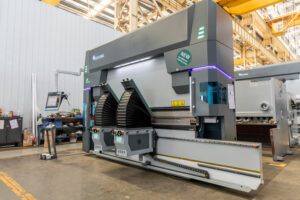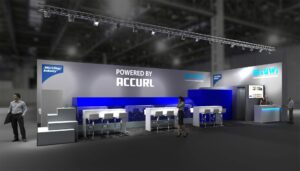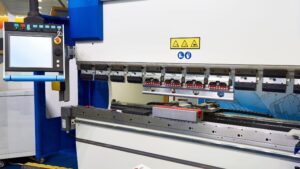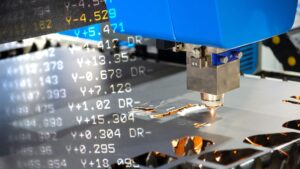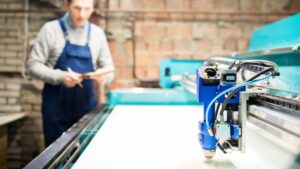If you’ve ever wondered about the transformation of a flat metal sheet into intricately designed parts, chances are you’ve come across the workings of a punch press. A punch press, an invaluable asset to the metal fabrication industry, is designed to shape or cut material by pressing a die or tool through it. The result? Metal pieces that are accurately shaped, all while ensuring a high level of productivity. Let’s dive into the captivating world of the punch press.
What is a Punch Press?

A punch press is a machine used in metalworking to shape or cut materials by pressing a die or tool through them. It’s a pivotal piece of machinery in the metalworking sector, enabling the creation of parts for myriad applications, from automobile components to building facades.
When Was the Punch Press Invented?
The advent of the punch press can be traced back to the early 19th century. Over the decades, its design and functionality have undergone significant advancements, keeping pace with technological innovations and ever-evolving industry demands.
What are the Main Components and Parts of a Punch Press?
A punch press might seem simple at a first glance, but it’s a complex system comprised of numerous parts working harmoniously.
Ram
The ram is the moving component of the press. Driven by the press’s main motor, it delivers the force required to engage the tooling and perform the punching process on the workpiece.
Frame and Worktable
This forms the basic structure of the press. The worktable, particularly, provides the surface where the workpiece is placed, ensuring stability during the punching process.
Drive and Control Mechanism
This component regulates the machine’s operations. It facilitates the control of movement, speed, and force exerted by the ram, ensuring precision in every punch.
Punch and Die
At the heart of the machine, these parts work in tandem to shape the metal. The punch provides the downward force, while the die gives the desired shape to the material.
Brakes
Safety is paramount. Brakes help in controlling the motion of the ram, ensuring it stops when desired, preventing accidents and enhancing precision.
Flywheel
This component stores rotational energy. It ensures consistent energy supply, especially during operations demanding high force.
Bolster Plate
It’s the thick plate onto which a die is mounted. It supports the die, ensuring stability during the punching process.
How Does a Punch Press Work?
The punch press operates through a sequence of finely-tuned steps:
- Setting up the machine by placing the metal sheet on the worktable.
- Adjusting the controls to set the desired force and depth.
- Engaging the ram, which moves downward to exert force.
- The punch and die come into play, shaping or cutting the metal.
- Withdrawing the ram and extracting the newly-formed part.
What are the Main Technical Parameters Associated with a Punch Press?

Punch presses come with an array of technical specifications:
- Force exerted by the ram (often in tons).
- Stroke length.
- Ram adjustment range.
- Worktable dimensions.
- Speed (strokes per minute).
- Power consumption.
Punch presses have revolutionized the metal fabrication industry by offering versatility and precision. These machines have distinct designs, mechanisms, and applications, setting them apart based on their efficiency, power consumption, and accuracy.
Flywheel Drive Punch Press
The Flywheel Drive Punch Press, driven by an electric motor, is a prime example of innovation in punch presses. Here’s how it works: during the non-working stroke, it accumulates energy in the flywheel. This stored energy then releases during the working stroke, making the punching process efficient and consistent.
Pros:
- Stable Power Consumption: The flywheel’s mechanism ensures consistent energy use during operations.
- Cost-Effective: Generally lower in price than some of its advanced counterparts.
- Easy Maintenance: Fewer complexities mean easy upkeep.
Cons:
- Limited Control Over Force: Its force remains constant, which might not be suitable for varied tasks.
- Not Ideal for Precision Tasks: Best for generic operations, not intricate designs.
Mechanical Drive Punch Press
Featuring gears and clutches, the Mechanical Drive Punch Press is a staple in heavy-duty operations. Its defining feature is the consistent force it provides, ensuring that every punch is precise and accurate, a testament to its mechanism.
Pros:
- Consistent Force: Ensures uniformity in products.
- Durability: Built for high-strength materials and extended use.
- Reliability: Minimal chances of unexpected halts or malfunctions.
Cons:
Limited Speed Adjustability: Might not be suitable for tasks requiring varied speeds.
Higher Operating Cost: Due to its heavy-duty nature, it consumes more energy.
Hydraulic Drive Punch Press
With the hydraulic ram at its core, the Hydraulic Drive Punch Press is built for precision. It uses hydraulic cylinders, granting operators more control over the ram’s speed and force. This type is crucial when the workpiece demands meticulous attention to detail.
Pros:
- Variable Force and Speed: Offers flexibility in operations.
- Precision: Excellent for tasks demanding intricate punches.
- Safety: Hydraulic systems provide a built-in emergency brake mechanism.
Cons:
- Maintenance: Requires periodic checks on the hydraulic system.
- Higher Initial Cost: Precision and flexibility come at a premium.
Servo Drive Turret Punch Press
Blending the versatility of the turret with the precise control of a servo motor, the Servo Drive Turret Punch Press is an epitome of efficiency. This machinery is particularly suitable when there’s a need to frequently change punches or dies for varied designs.
Pros:
- Versatility: Quickly change between tools, reducing downtime.
- High Accuracy: Servo motors ensure each punch is precise.
- Energy Efficiency: Consumes power only during the punching process.
Cons:
- Price: More expensive than traditional punch presses.
- Requires Skilled Operators: Its features demand knowledge and experience.
CNC Punch Press
Incorporating computer numerical control, the CNC Punch Press redefines precision. Whether it’s sheet metal or thicker materials, this machine ensures repeatability and unmatched accuracy, catering to intricate designs with ease.
Pros:
- High Precision: Delivers accurate punches every time.
- Repeatability: Consistent results across batches.
- Automation: Reduces manual intervention, increasing productivity.
Cons:
- Higher Cost: Advanced technology commands a higher price.
- Complexity: Requires operators with CNC knowledge.
What are the Supported Materials for a Punch Press?
Punch presses can work on a variety of materials:
- Mild steel.
- Stainless steel.
- Aluminium.
- Brass.
- Copper.
- And many more.
What are the Advantages of a Punch Press?

Precision and Repeatability
A standout feature of punch presses, including the turret punch press, is their incredible precision. Every stroke operation is meticulously controlled, and the results are not just precise but also highly repeatable. This ensures that even in mass production, each workpiece comes out with the same high level of accuracy.
- Tooling and Die Configurations: The machine’s tooling and die configurations offer a range of designs, shapes, and sizes. This diverse set allows manufacturers to create multiple identical units without variations in shape or size.
- Reliability and Control: The hydraulic ram and the hydraulic cylinder, integral parts of a punch press, ensure consistent force application. Such reliability is vital, especially when dealing with materials that demand a specific pressure or force for optimal results.
Production Speed and Efficiency
Speed and efficiency define the performance of a punch press. For businesses focusing on large-scale production, investing in a punch press is economical in the long run due to its high production speed.
- Cycle and Operation: Every operation, from the movement of the turret to the ram deceleration and the return action, is optimized for minimal time wastage. The processes are streamlined, ensuring faster production cycles.
- Automation and Productivity: Modern punch presses integrate CNC technology, increasing automation and reducing the need for manual interventions. This not only boosts productivity but also ensures consistency across all produced units.
Versatility in Materials and Shapes
The turret punch press and other types of punch presses can handle a broad range of materials, from sheet metal to thicker steel plates. Their versatility doesn’t stop at materials alone.
- Material Diversity: From air-thin sheets to more substantial steel plates, punch presses exhibit a broad range of material handling capacity. This versatility ensures that industries with varied needs can rely on this singular machine for multiple applications.
- Shape Creation: The intricate tooling and die systems support the creation of different shapes and patterns. Whether it’s round holes or more complex designs, a punch press can deliver with precision.
Economical Aspects and Operating Costs
Large-scale production often comes with increased costs. However, the punch press, with its design and efficiency, proves to be an economical choice for manufacturers.
- Power Consumption and Energy Efficiency: Modern punch presses, especially those with hydraulic systems, have optimized power consumption. The hydraulic ram, combined with a stable drive system, ensures that energy is used efficiently, leading to reduced operating costs.
- Maintenance and Longevity: With features like an emergency brake system and a robust frame structure, these machines promise durability. Their design minimizes wear and tear, reducing maintenance costs over time.
Additional Advantages to Consider
Beyond the core benefits, punch presses offer a plethora of other advantages that further solidify their position in the industry.
- Noise Control: Unlike some heavy machines, punch presses have mechanisms that control noise levels. This makes them more suitable for environments where noise pollution can be a concern.
- Safety Features: The design of the machine takes into account potential accidents. Features such as pinch points, stopping mechanisms, and emergency braking systems ensure the safety of operators.
- Customizability: Manufacturers today offer punch presses that can be customized based on specific industry needs. From varying tonnage capacity to different types of drive shafts and motors, the customization options are vast.
What are the Applications of a Punch Press?
Acting as a reliable bridge between design and product, the punch press uses its powerful hydraulic ram to transform sheets of metal into shapes and designs that serve varied purposes. Here’s a closer look at some of its chief applications:
Automotive
The automotive industry heavily depends on precision and consistency, which is where the turret punch press finds its significance. A large portion of vehicle parts, like brackets and panels, owe their existence to the punching machine.
Thanks to the force exerted by the hydraulic ram, the metal sheet is deformed into the required shape. The use of a punch press in this industry not only optimizes the production process but also ensures that every part meets the exact specifications set by the manufacturer.
Construction
When you see those massive cranes or the skeleton of a building being erected, it’s hard to fathom that many of its parts were once flat metal sheets. The construction industry employs punch presses for producing vital structural components.
The turret punch process, backed by its hydraulic cylinder, offers the strength and reliability required for components that bear heavy loads. The machine’s design ensures that every punched part, whether a T-bolt or a frame element, is manufactured with utmost accuracy.
Electronics
The era of electronics is marked by sleek designs and sturdy components. And this is where the punch press machine plays a pivotal role.
Crafting intricate casings and panels for devices is a task that demands precision and efficiency. Given the machine’s stroke operation, electronics manufacturers can rely on it to produce parts that are both aesthetically pleasing and functionally sound.
What are Potential Hazards and Dangers of a Punch Press?
Operating heavy machinery, including punch presses, inherently involves risks. Awareness is vital to ensure safety:
- Pinch points: Where moving parts come in contact, creating a risk of trapping.
- Unexpected startups: Accidental initiation can result in severe injuries.
- Flying debris: Bits of materials can dislodge during operations.
- Overloading: Exceeding the press’s capacity can lead to breakages or malfunctions.
- Inadequate safety measures: Absence of guards or safety interlocks can be hazardous.
How Much Does a Punch Press Cost?
The cost of a punch press can vary significantly based on its type, capacity, and features. On average:
- Small, manual punch presses: $500 to $5,000.
- Mid-range, with more features: $10,000 to $50,000.
- High-end, CNC or industrial grade: $100,000 and above.
How to Choose a Punch Press Machine?

Selecting the right punch press is pivotal for operational success:
- Evaluate your requirements: Understand the type of work and materials you’ll handle.
- Consider machine capacity: Ensure it matches your production needs.
- Assess precision needs: For intricate designs, opt for higher precision machines.
- Determine the available space: Machines come in varying sizes.
- Budget: Find a balance between requirements and available funds.
Speaking of punch presses, AccurlUSA is making waves in the industry. Their ES NT Series Electro Servo CNC Punch Press 30 ton is a testament to advanced technology and precision. With REXROTH AC Servo drive technology, it promises high speed, unparalleled precision, energy savings, and minimal noise. Designed by AccurlUSA’s seasoned R&D team, it stands as an epitome of reliability and reduced operating costs.
What are Alternative Machines to the Punch Press?
Stamping Press
Unlike the punch press that shapes or cuts materials with a single action, the stamping press uses a die to form the material with continuous actions. While punch presses are ideal for producing larger quantities of intricate designs, stamping presses are better suited for massive production of simpler parts.
Conclusion
The punch press, a stalwart in the metal fabrication industry, is essential for creating precise and consistent parts. From its intricate components to its wide-ranging applications, understanding its operations and advantages can provide a unique edge. Whether you’re in the market for a new machine or seeking to understand its prowess, this guide offers a comprehensive overview of the majestic punch press.
FAQs
1. Is a Punch Press a Forming Machine?
Yes, a punch press is a type of forming machine. It shapes or cuts materials by pressing a tool or die through them.
2. How Loud is a Punch Press?
The noise level can vary based on the type and size of the punch press. Typically, they can range from 70 dB to 90 dB, with larger machines generally producing more noise.


